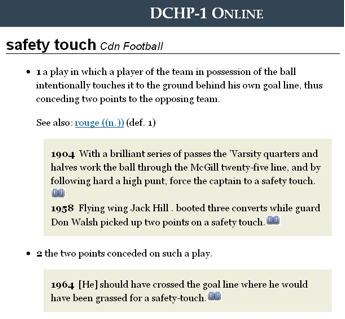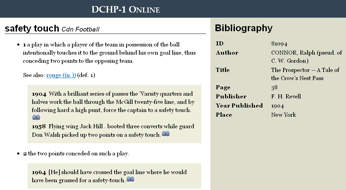DCHP-1 Online
How To Use
The menu bar on the left screen offers the reader two viewing modes for DCHP-1 Online. Browsing and full-text Searching, “quicksearch”. Show reference explains how to call up a citation’s reference. Differences between the paper version and DCHP-1 Online are shown here.
Browsing
Browsing allows the user to access the online version in a similar way to the paper version. Headwords are listed in alphabetical order in a ‘short view’ mode, with the option to ‘Expand +’, i.e. show all meanings, or to directly ‘Go to full entry’. For the example, below the entry for safety touch is shown in the abbreviated view:

Safety touch: abbreviated view in browse or search modes
Clicking ‘Expand +’ produces the term’s second meaning, i.e. “2. the two points conceded on such play.”:

Safety touch with “Expand +” button clicked
Clicking “Go to full entry >” produces the entire dictionary entry for safety touch:

The full entry displays the headword, all regional and usage labels (in this case Canadian Football, as a register label), followed by meanings and definitions, by cross references – in this case: rouge ((n.)) (def. 1) – and the dated citations as linguistic evidence.
Searching
A search window is shown in the top-left corner (“quicksearch”). This function is retrieving all text strings in three contexts: in headwords, citations and in other text, the latter category means anywhere else in the dictionary entries (such as in meanings, etymologies, fist notes or in usage labels, …) but neither in headwords nor in citations. Search terms are highlighted in red. After a search, the red highlighting can be undone by pressing the “refresh” button of your browser.
The search installed here is simple and straightforward. It is blind to letter case and blank spaces. For instance, a search for “rouge” produces all terms, sorted in the three categories headwords, citations and ‘other text’, that contain the character string. Results are displayed in alphabetical order. For a search of “rouge”, the results in headwords are:
barouge, bois rouge, bonnet rouge, Parti Rouge, Rouge, rouge ((n.)), rouge ((v.)), Rouge party
These eight headwords are followed by 44 quotations and 3 definitions containing the character string. Simple scrolling will quickly produce the desired term.
Show reference
Clicking on the book symbol after each citation,  , produces the full bibliographic reference, which is shown in Scan 4 for the 1904 citation of Scan 3, Meaning 1.
, produces the full bibliographic reference, which is shown in Scan 4 for the 1904 citation of Scan 3, Meaning 1.

Differences between paper and online editions
DCHP-1 Online is a web-based version of a historical document. As a general rule, DCHP-1 Online is a precise replication of DCHP-1, with all its shortcomings, that exploits the advantages of a digital environment. No attempts were made to correct or update the original work. DCHP-1 Online includes, therefore, terms and perspectives that are out of date today or would need to be marked by different usage labels, e.g. Eskimo†.
Five main changes must be addressed:
First, the bibliography, formerly divided into periodicals and book publications and listed at the end of the book, has been integrated with the citations. A citation is the dated, textual evidence that is listed in chronological order for each meaning. Each citation, by link via the book symbol,  , features the same bibliographical record in hyperlinked form as the print edition. Here some obvious errors of referencing were corrected.
, features the same bibliographical record in hyperlinked form as the print edition. Here some obvious errors of referencing were corrected.
Second, DCHP-1 Online’s browsing mode displays the words similarly to the paper format. However, DCHP-1 Online uses “electronic” ordering, listing punctuation before alphabetical signs. Punctuation and capital letters are treated differently. For instance, the beginning of letter “S” shows the alphabetic sequence of the headwords in the following way:
DCHP-1 Paper starts with the following headwords:
Sabine(‘s) gull, sablefish, Sable Island pony, sac à commis, saccacommi(s), sachem†
DCHP-1 Online shows this sequence:
S.D., S.S., S.S.B., Sabine(‘s) gull, Sable Island pony, sablefish, sac à commis, saccacommi(s), sachem†
Punctuation is given preference (S.D., S.S., and S.S.B. are ranked first), as is upper case (hence Sable Island pony occurs before sablefish).
Three, headwords use double round parentheses, (( )), to distinguish different meanings of the same word, as in the case of kiack1 and kiack2, now rendered as kiack ((1)) and kiack ((2)). Double parentheses are also used to distinguish the part of speech of otherwise identical headwords, e.g. Canuck ((n.)) and Canuck ((adj.)).
Four, to economize on space, the paper DCHP-1 makes use of the “See” device (as well as q.v., cf., cp.) to refer to terms and definitions that occur elsewhere in the text. DCHP-1 Online maintains all references to related terms with the “See also” hyperlink tool, but also repeats the definition in all relevant locations.
Five, the rare pronunciation transcriptions were omitted. They are identical to those in the Gage Canadian Dictionary (1997).